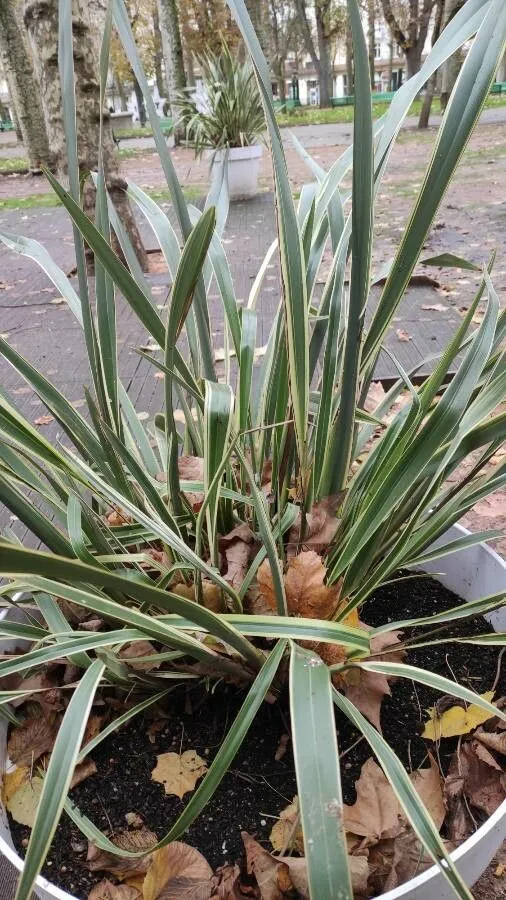
Author: J.R.Forst. & G.Forst.
Bibliography: Char. Gen. Pl.: 48 (1776)
Year: 1776
Status: accepted
Rank: species
Genus: Phormium
Vegetable: False
Observations: Norfolk I., New Zealand
New Zealand Flax is a magnificent plant known for its striking appearance and versatile nature. Scientifically referred to as Phormium tenax, it was first described in “Char. Gen. Pl.: 48 (1776)” by J.R. Forster and G. Forster. This perennial plant is native to Norfolk Island and New Zealand, reflecting its origins in its common name.
Belonging to the family Asphodelaceae, New Zealand Flax displays robust leaves that can grow up to 3 meters in length. These leaves are typically long, fibrous, and sword-shaped, exhibiting a range of colors from deep green to bronze, red, and even variegated tones. The plant’s architecture not only makes it an excellent structural element in landscaping but also a subject of admiration for its ornamental value.
New Zealand Flax thrives in a variety of environments, demonstrating remarkable adaptability. It can be found in coastal areas, wetlands, and even on rocky cliffs. This adaptability is largely due to its strong root system and resilient nature, allowing it to withstand harsh weather conditions, including fierce coastal winds and saline environments.
In addition to its striking visual appeal, Phormium tenax has a rich history of utilitarian use by the Māori people of New Zealand. The fibrous leaves were traditionally harvested and processed to create strong, durable textiles. These materials were used to craft a variety of items, including ropes, baskets, mats, and clothing. The flax’s significance extends beyond material use, embedding itself into the cultural and historical tapestry of New Zealand.
New Zealand Flax also produces a notable flowering stalk that can rise above the foliage, bearing tubular flowers that vary in color from red to yellow. These flowers are rich in nectar and attract a variety of birds, including native species like the tui and bellbird, which play a critical role in the plant’s pollination process.
Modern cultivation of Phormium tenax extends beyond the borders of New Zealand and Norfolk Island, with gardeners and landscapers around the world incorporating this diverse plant into their designs. Its hardiness and minimal maintenance requirements make it a popular choice for those looking to introduce dramatic foliage and structure into gardens and public spaces.
In summary, New Zealand Flax, or Phormium tenax, is a remarkable plant that combines robust adaptability, historical significance, and striking ornamental value. Its presence in both ancient cultural practices and contemporary horticulture underlines its enduring appeal and functional versatility.
Eng: new zealand flax, new zealand-flax, new zealand-hemp, harakeke
Por: formio, linho-da-nova-zelandia
Spa: lino de nueva zelanda, lirio de espada
Swe: nyzeeländskt lin
Cym: llin seland newydd
En: New Zealand Flax, New Zealand-flax, New Zealand-hemp, Harakeke
Nl: Nieuw-Zeelands Vlas, Nieuwzeelands Vlas
De: Neuseeländer Flachs
Pt: Formio, Linho-da-nova-zelandia
Es: Lino de Nueva Zelanda, Lirio de espada, Formio común
Sv: Nyzeeländskt lin
Cy: Llin Seland Newydd
: New zealand flax
Taken Dec 7, 2021 by Daniel Da Parigi (cc-by-sa)
Taken Nov 28, 2019 by Dieter Wagner (cc-by-sa)
Taken Aug 13, 2019 by jay twyford (cc-by-sa)
Taken Dec 8, 2021 by Dieter Albrecht (cc-by-sa)
Taken Dec 8, 2021 by Dieter Albrecht (cc-by-sa)
Taken Feb 4, 2022 by Fabrice Rubio (cc-by-sa)
Taken Jan 7, 2022 by David Hocken (cc-by-sa)
Taken Nov 1, 2022 by Véronique Lemercier (cc-by-sa)
Taken Feb 4, 2022 by Fabrice Rubio (cc-by-sa)
Taken Dec 8, 2021 by Dieter Albrecht (cc-by-sa)
Taken Jul 31, 2020 by steven hall (cc-by-sa)
Taken Oct 8, 2019 by Jocelyne Jocelyne Renouf (cc-by-sa)
Taken Jun 10, 2016 by Tela Botanica − Bernard SUDAN (cc-by-sa)
Taken Mar 24, 2019 by Jose Carlos Cordo Mollar (cc-by-sa)
Taken Jul 16, 2019 by Javier López (cc-by-sa)
Taken Jul 15, 2021 by Joan Francesc (cc-by-sa)
Taken Jul 18, 2021 by Gaelle Lottier (cc-by-sa)
Taken Apr 27, 2022 by Alboss (cc-by-sa)
Taken Aug 24, 2019 by Dmitry Gorelov (cc-by-sa)
Taken Feb 4, 2022 by Fabrice Rubio (cc-by-sa)
Taken Aug 24, 2021 by Jean-René Girardeau (cc-by-sa)
Taken Jan 1, 2021 by tom tom (cc-by-sa)
Taken Jul 22, 2021 by Anto Allen (cc-by-sa)
Taken Aug 14, 2022 by Auvray Gilbert (cc-by-sa)
Taken Jul 19, 2021 by Veit Koch (cc-by-sa)
Taken Aug 1, 2021 by Jonathan Golan (cc-by-sa)
Taken Nov 26, 2021 by Audrey Misner (cc-by-sa)
Taken Jul 4, 2022 by aria salan (cc-by-sa)
Taken Jul 27, 2022 by Cristina Sanz Sánchez (cc-by-sa)
Taken May 15, 2022 by Patrick Fabreteste (cc-by-sa)
© copyright of the Board of Trustees of the Royal Botanic Gardens, Kew.
© copyright of the Board of Trustees of the Royal Botanic Gardens, Kew.
© copyright of the Board of Trustees of the Royal Botanic Gardens, Kew.
Growth habit>: Subshrub, Forb/herb
Family: Myrtaceae Author: (F.Muell.) K.D.Hill & L.A.S.Johnson Bibliography: Telopea 6: 402 (1995) Year: 1995 Status:…
Family: Rubiaceae Author: Pierre ex A.Froehner Bibliography: Notizbl. Bot. Gart. Berlin-Dahlem 1: 237 (1897) Year:…
Family: Sapindaceae Author: Koidz. Bibliography: J. Coll. Sci. Imp. Univ. Tokyo 32(1): 38 (1911) Year:…
Family: Asteraceae Author: A.Gray Bibliography: Pacif. Railr. Rep.: 107 (1857) Year: 1857 Status: accepted Rank:…
Family: Fabaceae Author: Medik. Bibliography: Vorles. Churpfälz. Phys.-Ökon. Ges. 2: 398 (1787) Year: 1787 Status:…
Family: Aspleniaceae Author: (Cav.) Alston Bibliography: Bull. Misc. Inform. Kew 1932: 309 (1932) Year: 1932…